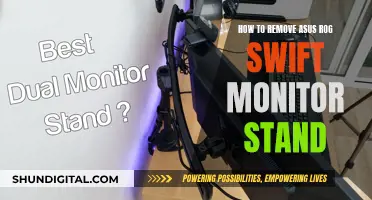
Touchscreen monitors are a new breed of display that allows users to interact with their PCs in a whole new way. They are becoming increasingly popular as they offer a more intuitive way to interact with your computer. However, they are not for everyone and come with their own set of advantages and disadvantages. On the one hand, they can be a lot of fun to use, provide a more intuitive user experience, and are especially useful for younger children who learn more through touch. On the other hand, they can be impractical, uncomfortable, and are not always compatible with all software. So, is it worth it to buy a touch monitor? The answer depends on your specific needs and preferences.
| Characteristics | Values |
|---|---|
| Ergonomics | Touchscreens can cause arm strain and are not considered ergonomic. |
| Ease of Use | Touchscreens are considered less easy to use than traditional mouse and keyboard. |
| Use Cases | Touchscreens are ideal for less data-centric, less keyboard-heavy work. |
| Industry Trend | Touchscreen technology is becoming more popular and may eventually replace traditional input methods. |
| Cost | Touchscreen monitors typically cost $20 to $100 more than non-touchscreen monitors. |
| Productivity | Opinions vary on whether touchscreens increase productivity. Some believe they can streamline navigation and improve efficiency, while others find them unnecessary or even detrimental to productivity. |
| Compatibility | Touchscreen monitors are generally compatible with Windows, Linux, and Android operating systems but not with macOS. |
| Image Quality | Touchscreen monitors may offer better colour accuracy and contrast than non-touchscreen monitors, depending on the type of LCD display used (IPS, VA, or TN). |
| Portability | Touchscreen monitors can be more portable and convenient for travel, depending on their size and design. |
What You'll Learn
- Touchscreen monitors can be a fun way to interact with your PC
- They are especially useful for younger children who learn through touch
- Touchscreens are more intuitive and natural than a mouse and keyboard
- They can be a good option for industries with limited space
- Touchscreens are not always practical for everyday use

Touchscreen monitors can be a fun way to interact with your PC
Touch displays also eliminate the need for a standard computer mouse and keyboard, providing immediate navigation and accessibility through physical touch control. This reduces the amount of space required for touch monitors and makes them easier to carry along while travelling. The best touchscreen laptop is easy to use, fun to navigate, and comes in sleeker models as well. Touchscreens also simplify and speed up the operation of gadgets. The process of determining where the mouse is on the page is more time-consuming. The touch screen is easier to use as you can locate and touch exactly what you need.
However, there are some drawbacks to touchscreen monitors. One of the main issues is the dreaded "gorilla arm", where screens are vertical and usually located farther away, making it harder to use them. Another issue is that your hands can block your view of the screen. Additionally, most software is built for a mouse-first experience, and the novelty of a touchscreen monitor may wear off as you realise that 99% of programs are built for a mouse-first, and everything else second.
Kids' Monitor Size: Big or Small Screen?
You may want to see also

They are especially useful for younger children who learn through touch
Touchscreen monitors can be extremely beneficial for younger children as they provide an intuitive and engaging way to interact with digital content. Children often find touch-based interactions more natural and accessible than traditional input methods like keyboards and mice. This is especially true for those in their early years who are still developing fine motor skills and coordination.
Touch monitors offer a tactile and immersive experience that can enhance children's learning. Interactive touch activities can stimulate their senses and keep them engaged, making learning fun and enjoyable. This kinesthetic approach to learning, where children can directly manipulate objects on the screen, has been shown to improve comprehension and retention.
Educational apps and games designed for touch input can provide a wealth of interactive and educational content tailored to a child's age and learning level. These often include elements like drag-and-drop interactions, visual simulations, and interactive stories that encourage active participation and promote hands-on exploration of concepts.
Additionally, touch monitors can facilitate a more collaborative and social learning experience. Children can work together on the same screen, promoting teamwork and peer learning. This can be especially beneficial for group projects or classroom activities, fostering a more interactive and dynamic learning environment.
For parents and educators, touch monitors offer a versatile tool that can adapt to different learning needs and styles. They can be used for everything from early literacy and numeracy skills to more advanced subjects, providing a platform that grows with the child. The intuitive nature of touch interaction also reduces the barrier to technology adoption, allowing children to focus more on the learning content than the intricacies of the device.
Installing ASUS ROG 27 Monitor Drivers: A Step-by-Step Guide
You may want to see also

Touchscreens are more intuitive and natural than a mouse and keyboard
Touchscreen monitors are a new breed of display that allows users to interact with their computers in a whole new way. While they may not be for everyone, touchscreens are more intuitive and natural than a mouse and keyboard for several reasons.
Firstly, touchscreens are more user-friendly and accessible to a broader audience. Touch interactions are simple and natural, allowing users to open apps, write messages, and perform other tasks with ease. The learning curve for mastering a touchscreen is also relatively shallow, making it a preferred choice for many, especially younger users who have grown up with touchscreen devices like iPads and iPhones.
Secondly, touchscreens are more responsive than a keyboard and mouse. They react almost immediately to touch commands, reducing input errors and providing a smoother user experience. This high level of responsiveness is particularly advantageous in certain industries, such as retail and restaurants, where efficiency and speed are crucial.
Thirdly, touchscreens conserve space. Unlike traditional keyboards and mice, touchscreen interfaces are embedded within the display device, eliminating the need for additional peripherals. This makes touchscreen monitors ideal for small spaces and mobile work setups.
Additionally, touchscreens are typically more durable than keyboards and mice. They are sealed and less susceptible to damage from dust, dirt, or other debris. This makes them a more reliable choice, especially in environments where contaminants may be present.
Lastly, touchscreens offer a more versatile and interactive way of interacting with digital devices. Gestures, swiping, and tap patterns can be faster and more intuitive than traditional keyboard shortcuts or mouse clicks. This versatility opens up new possibilities for innovation in software design and user experiences.
While there are valid counterarguments, such as the issue of "gorilla arm" with screens positioned vertically, the advantages of touchscreens in terms of intuitiveness and natural interaction are significant. Touchscreen technology has the potential to revolutionize how we interact with computers, just as the introduction of the mouse did decades ago.
Connecting Your MacBook to Monitors: A Comprehensive Guide
You may want to see also

They can be a good option for industries with limited space
Touchscreen monitors are an ideal option for industries with limited space. They eliminate the need for a standard computer mouse and keyboard, which reduces the amount of space required for touch monitors and makes them easier to carry along while travelling.
Touchscreen monitors are also highly portable and can fit into any bag, briefcase, or backpack. This makes them perfect for business travellers, remote workers, and digital nomads. They can serve as complementary touchscreens to a laptop or tablet, boosting productivity.
Additionally, touchscreen displays offer a variety of new control options that are not possible with conventional monitors. For example, users can simply magnify the screen by touching it with their fingers, which is faster and easier than using a keyboard and mouse.
Touchscreen technology also simplifies and speeds up the operation of gadgets. The process of locating the mouse on the page is more time-consuming than directly touching the desired location on a touchscreen. This can save a significant amount of time, especially when performing repetitive tasks.
While touchscreen monitors may not be for everyone and can have issues such as "gorilla arm" (where screens are too vertical and located too far away, making them uncomfortable to use), they can be a good option for industries with limited space.
Monitor Measurements: Know Your Screen's Dimensions
You may want to see also

Touchscreens are not always practical for everyday use
Touchscreen monitors are not always practical for everyday use. While they can be fun to use and allow users to interact with their PCs in new ways, they are not for everyone. Touchscreen monitors often require users to put in the time to learn how to navigate them. They can also be awkward to use, with users reporting that their hands and arms block their view of the screen. This issue, known as "gorilla arm", is especially common with vertical screens that are located at a distance, such as desktop monitors.
Touchscreen monitors can also be unreliable, with users reporting issues such as unresponsiveness and inaccurate responses. These problems may be caused by display incompatibility, driver issues, or calibration problems, among other things. Touchscreen technology also tends to work poorly, or not at all, when users are wearing gloves.
In addition, while touchscreens can be intuitive and easy to use for younger generations who have grown up with smartphones and tablets, they may be less so for older users who are more accustomed to traditional input devices like keyboards and mice.
Finally, while touchscreen technology has the potential to change and expand the way we interact with technology, it may not always be necessary or beneficial. For example, in a business context, touchscreen monitors may be useful for certain industries, such as retail, but may not offer any advantages for employees who primarily work with spreadsheets and databases.
Asus VG248QE Monitor: Performance and Features Review
You may want to see also
Frequently asked questions
Touchscreen monitors are not for everyone. They can be fun to use and offer a new way to interact with your PC, but they are not necessary for most users. Light, agile tablets are often cheaper and more portable, and the mouse-keyboard combination is still the most popular way to interact with computers.
Touch monitors can be a good option for people who need a space-saving alternative, as they don't require a mouse or keyboard. They are also easy to use and can speed up certain processes, such as checking into an office or controlling an arrangement. Touch monitors can be especially useful for younger children who learn more through touch than they do through interacting with a mouse and keyboard.
Touch monitors can be uncomfortable to use, as they are often vertical and require you to hold your arm out to interact with them. They are also not always compatible with certain software and programs, which are designed with mouse and keyboard use in mind.







